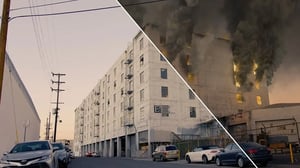
Compositor
TABLE OF CONTENTS
What does a compositor do?
VFX compositors seamlessly integrate CG assets, matte paintings, and live-action footage to make a single moving image, known as a shot. They match each layer in terms of light and shadow, color and grading, perspective, and depth, while also ensuring each shot maintains continuity within its sequence.
Before digging into their shot, compositors may also be required to research real-life examples, watch reference videos (when possible), and generate multiple concepts.
Oscar-nominated VFX Supervisor and CG Spectrum Mentor, Genevieve Camilleri talks about how she tackles a shot as a compositor:
“I will begin blocking the shot out and problem-solving what assets, elements, and techniques will be required. I then begin to build the shot up creatively. I always try to find real-world references to support the work I am doing. Once the supervisors and myself are happy, I then begin to polish and refine my work on a more technical level.”
VFX compositor job description
When watching a film, on first inspection, it might seem tricky to determine what a compositor was responsible for, which is actually the point! It’s their job is to create seamlessness in and between shots.
As compositing is the last step of the VFX pipeline, compositors must combine all the 2D and 3D elements that make up a shot, ensuring they appear as though they naturally belong in the same space. For example, they may be given a foreground element that has been shot in front of a green screen which they need to integrate with a matte-painted background, CG characters, and FX elements.
Compositors are often also responsible for smoothing out an actor’s appearance to appear younger (de-aging), and adding 2D effects such as dust particles, lens flare, motion blur, and graphics.
Role & responsibilities of a compositing artist in film:
- Integrating 2D and 3D elements of a shot while balancing the creative and technical side of each component
- Paint fixes, rotoscoping, chroma keying, colour and grading continuity, graining/degraining images
- Stitching plates (live-action footage) together
- Working with blue/green screen effects, creating mattes
- Enhancing lighting effects and creating convincing shadows within a shot
- Integrating rear projection into background images

How much does a VFX compositor make?
Wages for compositing artists start at around USD $77,000 and peak at around USD $138,000 (glassdoor.com).
Skills required to become a VFX compositor
Skills required to become a VFX compositor
Compositors require a mix of technical, creative skills, and interpersonal skills. The VFX industry is a highly collaborative environment—a single shot will often travel through multiple departments before reaching the Compositing Department—so a Comper must be able to work well in a team, and have a solid understanding of the VFX pipeline.
Employers may look for the following skills in a compositor:
- A solid understanding of composition, color theory, and image properties
- Strong understanding on the visual effects pipeline
- Extensive Nuke knowledge and experience (demonstrated via showreel)
- Photographic skills - understanding depth of field, shutter speed, lighting, aperture, composition, and framing
- An understanding of stereo (3D) and anamorphic compositing in Nuke
What software and tools do compositing artists use?
Compositors must be highly competent in Nuke.
VFX compositors may be required to use some or a combination of the following software:

Maya is a comprehensive 3D animation software used for creating detailed models, animations, and visual effects. It's popular in film, TV, and game development for its powerful tools.

Nuke is a node-based digital compositing and visual effects application first developed by Digital Domain and used for television and film post-production

Adobe After Effects is a digital visual effects, motion graphics, and compositing application developed by Adobe Inc
A day in the life of a compositing artist
If you want to work as a compositor, you need to understand every step of the VFX pipeline.
The visual effects production pipeline refers to the various stages of production required to add visual effects to a film of TV show. The pipeline organizes each department so that every artist knows their role, and a production can move along within the allocated timeline. The production pipeline differs slightly between film and game production, and roles will vary depending on studio size.
Compositors work in post-production and ensure that all the visual elements of a film, TV show, or advertisement are blended seamlessly on the screen. They deal with a complex combination of images including green screen sequences, special effects, visual effects, mattes, and live action coming together to complete a believable whole.
How to become a Compositor
To get a job in VFX, you’ll need an amazing demo reel! Here are some tips to get you started. Don't forget to check out VFX supervisor Jorge Razon's top demo real and interview tips.
- Students, keep your reel < 1 min. If you have 1–2 years experience, < 2 mins.
- Include any production experience you have.
- Breakdowns are good but keep it to 3–4 quick wipes.
- Always Include breakdown descriptions where applicable.
- Use Vimeo— the video quality is better than YouTube.
- Everything in your reel should be 10/10, do not include mediocre work.
- Keep the music fairly conservative, nobody listens to it anyway.
- Watch your reel a lot of times and look for comp, edit, frame or spelling errors.
- Get feedback from at least 3 instructors or industry pros before releasing online.
- Show reference footage when applicable.
- Share your reel with the world via LinkedIn, Facebook, Instagram.
Almost all schools train students to become generalists. If you are applying for VFX jobs at a small studio with less than 30 artists, they will most likely want a generalist. Larger studios will have separate departments, so a more specialized set of skills is desirable.

Ready to Start Your Film & Games Journey?
Download our course guide to see how we can help you on your pathway to your dream career.Tips to break into the VFX industry
“FX are everywhere in movies, TV, games and advertising... frosty breath, blood splatter, bullet hits, sparks, clouds, ocean extensions and splashes. You may not think the movie you’re watching has many FX, but wait for the end credits.” - Magdalena Bisogni, VFX Producer and Recruiter
Increase your chances of getting hired with these strategies for success:
Download software
Trial VFX programs like Maya, Nuke or Houdini Apprentice.
Build skills
Build the skills companies are listing on job sites. For more support, enroll in a reputable course. CG Spectrum’s FX courses include mentorship from VFX pros and an industry-led curriculum.
Watch trends
Online tutorials, interviews, webinars, and events can help keep your skills fresh.
Network
Networking is vital. Familiarize yourself with the industry and build your community. Interact online and in real life with industry pros who might offer advice, insights, or job opportunities.
Intern
Internships at VFX or game studios can help you break into the industry. It’s one way to gain hands-on experience, network, and experience studio life.
Join contests
Practice your skills and create assets for your reel by participating in contests and challenges on sites like The Rookies, and ArtStation.
Share work
Social media is great for showcasing work, building an audience, having your work shared by others, and seen by potential clients and collaborators. See resources page for more.

Industry Pathways
Welcome to our brand new series, Industry Paths. Tune in to meet our professional mentors from across the film, games, and visualization industries and hear directly from them about how they got started, what a day in their life looks like, and why they do what they do. In this episode, you'll hear from Sean Amlaner, CG Spectrum's Department Head of VFX Compositing.


